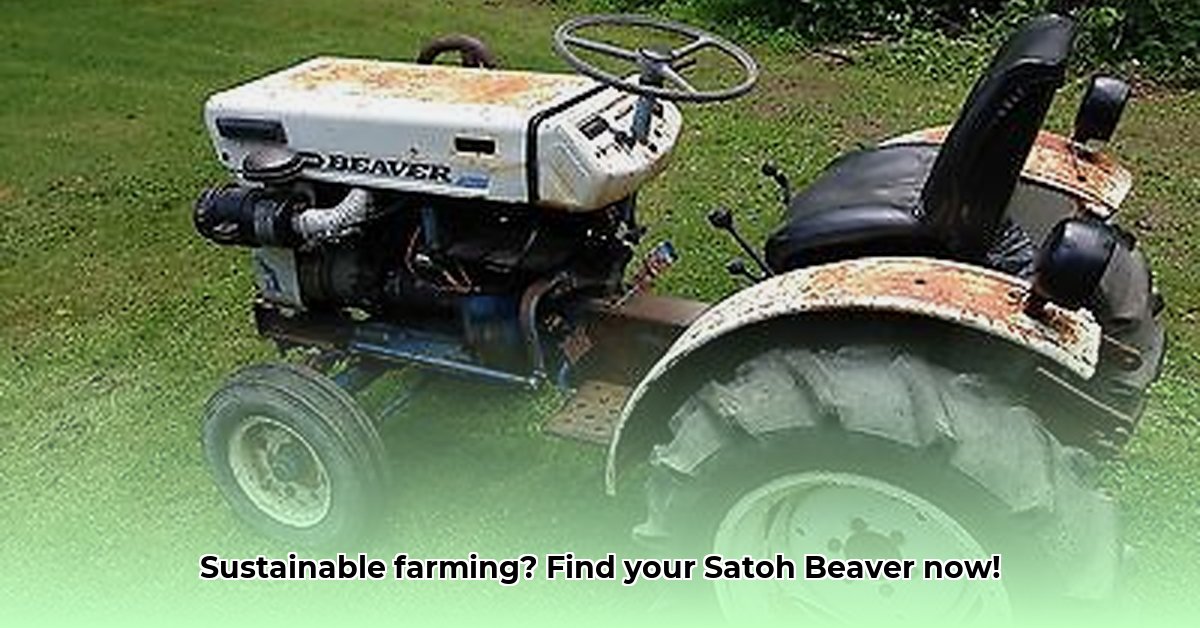
Finding the perfect used tractor can be a rewarding experience, especially when you're focused on sustainable and budget-friendly farming. The Satoh Beaver is a popular choice for its reliability and simplicity, making it ideal for smaller operations. However, purchasing a used tractor requires careful consideration and a thorough understanding of the market. For more information on tractor models and years, check out this helpful resource: tractor model information. This guide will equip you with the knowledge and tools necessary to navigate the process confidently and find a Satoh Beaver that fits your needs.
Exploring the Used Satoh Beaver Market
The market for used Satoh Beaver tractors is niche, meaning availability can be limited. Prices vary significantly depending on the model (like the popular S370D), condition, included implements (think tillers or loaders), and overall wear and tear. You might find listings ranging from a few thousand dollars to considerably more. This is why thorough research and a comprehensive pre-purchase inspection are paramount. Expect to spend some time searching, and remember that detailed photos are crucial, but a firsthand inspection is invaluable.
Your Pre-Purchase Inspection Checklist: A Step-by-Step Guide
Before committing to a purchase, a meticulous inspection is non-negotiable. This checklist will help you identify potential problems and ensure you're making a sound investment.
Step 1: Engine Assessment
- Start-up: Listen carefully for any unusual noises like knocking, rattling, or unusual sounds during engine start-up. A smooth start suggests good engine health.
- Oil Level Check: Inspect the oil level. Low oil levels could indicate leaks or more serious problems. Check for oil stains around the engine block.
- Compression Test (Recommended): While optional, a compression test provides a more precise evaluation of engine health. Consider hiring a qualified mechanic to conduct this test for a more thorough assessment.
Step 2: Transmission and Hydraulics Evaluation
- Gear Shifting: Shift through all gears. Smooth shifts are a good sign. Grinding, difficulty shifting, or resistance indicates potential problems.
- Hydraulic Fluid Check: Verify the hydraulic fluid level. Consistently low levels point to a leak, which requires immediate professional attention.
- Hydraulic Function Test: Test hydraulic functions if possible, utilizing any attached implements. Verify smooth and efficient operation.
Step 3: PTO and Implement Functionality
- PTO Engagement: Engage the power take-off (PTO) and listen for any unusual sounds. Abnormal noises indicate potential issues.
- Implement Inspection: Thoroughly inspect any included implements for signs of wear, tear, damage, broken parts, or missing components.
- Implement Function Test: Test the functionality of each implement; ensure seamless and expected performance.
Step 4: Documentation Review: The Tractor's History
- Maintenance Records: Request complete maintenance records. These documents provide valuable insights into the tractor's past care and maintenance. Regular maintenance often proves lower long term expenses.
- Ownership Verification: Obtain necessary documentation to verify ownership and ensure a clean transfer of title. This protects you from legal complications down the line.
Understanding the Total Cost: Beyond the Purchase Price
The purchase price isn't the only cost to consider. Account for the following:
- Immediate Repairs: Budget for unforeseen repairs that might be needed immediately after purchase.
- Routine Maintenance: Factor in regular maintenance such as oil changes, filter replacements, and other essential care.
- Parts Availability: Research parts availability for older Satoh Beaver tractors before purchasing. The difficulty in sourcing parts can significantly impact long-term costs.
Weighing the Pros and Cons: Is a Satoh Beaver Right for You?
| Pros | Cons |
|---|---|
| Lower initial purchase price | Parts availability may be challenging |
| Relatively simple design | Lower horsepower than newer models |
| Ideal for smaller farms and various tasks | Higher likelihood of needing repairs |
| Often good fuel efficiency | Older technology; potentially less efficient |
Locating Your Satoh Beaver: Where to Search
Start your search online using major agricultural equipment marketplaces, auction sites (proceed with caution!), and online forums and groups dedicated to farming and vintage machinery. Don't hesitate to check local dealers or spread the word within your farming community. Remember to conduct due diligence and be cautious of any deals that seem too good to be true.
Minimizing Risk: A Final Word of Caution
Buying a used tractor involves inherent risks. Prioritize a thorough pre-purchase inspection by a qualified mechanic, diligent research into parts availability, and a realistic budget for potential repairs. Take your time, ask questions, and don't be afraid to pass on a tractor that raises concerns. A cautious approach guarantees a more rewarding and productive experience.